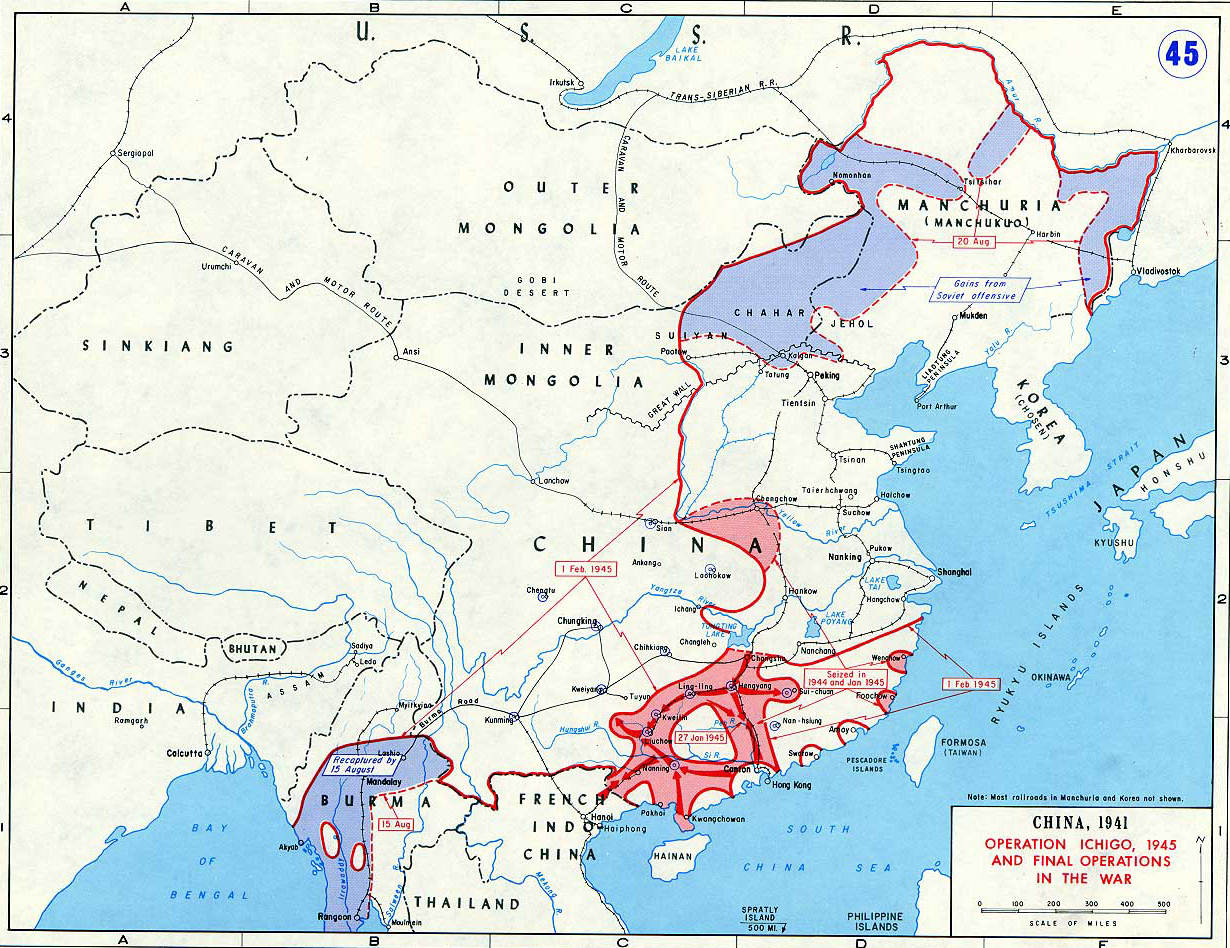Map Description
History Map of WWII: China 1945
Illustrating:
Operation ICHIGO (Japanese campaign in China)
Final Operations in the War
By January 1945, China was reeling from the impact of Operation Ichi-Go, the largest Japanese offensive of the Second
Sino-Japanese War, which had run from April to December 1944.
This campaign involved over 500,000 Japanese troops and
aimed to seize American air bases in southern China, secure a land corridor from Manchuria to French Indochina, and
control key railway lines.
While the Japanese achieved their operational objectives—capturing critical cities, airfields,
and railway links—their gains came at a high cost: about 100,000 Japanese dead and as many as 750,000 Chinese casualties,
including both military and civilian losses. (Note: Casualty figures (esp. Chinese side) vary widely.)
Strategic Consequences
The Japanese controlled major cities and railways in central and southern China, but their forces were overstretched and
unable to pacify the countryside, which remained contested by Chinese Nationalist and Communist guerrillas.
The operation failed to achieve its strategic goal of knocking China out of the war or significantly reducing the threat
of US air raids, as American bombers simply shifted to bases in the Pacific.
The Japanese occupation deepened chaos in the affected regions, undermining Nationalist authority and enabling Communist
forces to expand their influence in rural areas.
Chinese and Allied Response (1945)
In early 1945, the Chinese Nationalist government, led by Chiang Kai-shek, began planning counteroffensives to reclaim lost
territory, though these operations were limited by the exhausted state of Chinese
forces and the ongoing civil war with the Communists.
The US agreed to train and equip 36 Chinese divisions to bolster resistance against Japan.
The Nationalist government withdrew some troops from the Burma front to focus on internal operations, but their effectiveness
was hampered by poor morale, corruption, and logistical challenges.
Japanese Position and Final Operations
By 1945, Japan was on the defensive throughout Asia and the Pacific, facing mounting losses and supply shortages.
In China, Japanese forces attempted further advances, such as the Battle of West Hunan, but these failed due to overextension
and increasing Chinese resistance, supported by US air power.
The Japanese strategy shifted to holding their gains rather than further expansion, as the broader war situation deteriorated
rapidly.
Endgame and Surrender
The atomic bombings of Hiroshima and Nagasaki in August 1945, combined with the Soviet invasion of Manchuria, forced Japan's
surrender.
In China, the Japanese formally surrendered in September 1945, ending both the Second Sino-Japanese War and World War II in
Asia.
Broader Impact
Operation Ichi-Go exposed the weaknesses of the Chinese Nationalist regime and accelerated the shift in power toward the
Communists, setting the stage for the resumed Chinese Civil War after Japan's defeat.
The devastation of the war, including massive civilian casualties and destruction, left China deeply scarred and politically
unstable.
By 1945, the Japanese occupation in China was at its territorial peak but strategically hollow. Operation Ichi-Go had failed to
bring decisive victory, and the final months saw Japan on the defensive and Chinese forces regrouping with Allied support.
The
end of WWII in Asia marked the close of the Second Sino-Japanese War, but left China divided and poised for renewed civil conflict.
Credits
Courtesy of the United States Military Academy Department of History.
Related Links
About the Second Sino-Japanese WarAbout the Second World War
WWII Timelines
About Governments of China

